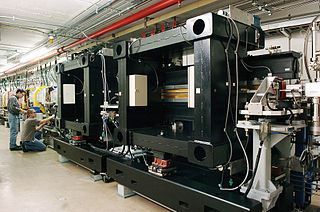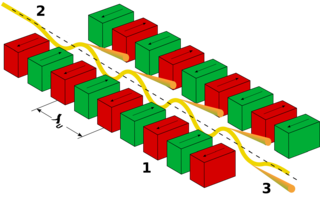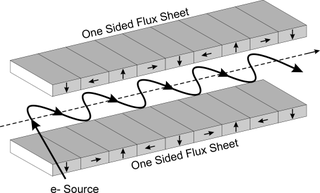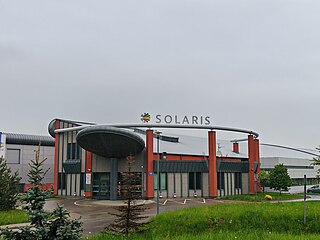
A synchrotron light source is a source of electromagnetic radiation (EM) usually produced by a storage ring, for scientific and technical purposes. First observed in synchrotrons, synchrotron light is now produced by storage rings and other specialized particle accelerators, typically accelerating electrons. Once the high-energy electron beam has been generated, it is directed into auxiliary components such as bending magnets and insertion devices in storage rings and free electron lasers. These supply the strong magnetic fields perpendicular to the beam that are needed to stimulate the high energy electrons to emit photons.

Diamond Light Source is the UK's national synchrotron light source science facility located at the Harwell Science and Innovation Campus in Oxfordshire.

An insertion device (ID) is a component in modern synchrotron light sources, so called because they are "inserted" into accelerator tracks. They are periodic magnetic structures that stimulate highly brilliant, forward-directed synchrotron radiation emission by forcing a stored charged particle beam to perform wiggles, or undulations, as they pass through the device. This motion is caused by the Lorentz force, and it is from this oscillatory motion that we get the names for the two classes of device, which are known as wigglers and undulators. As well as creating a brighter light, some insertion devices enable tuning of the light so that different frequencies can be generated for different applications.

A synchrotron is a particular type of cyclic particle accelerator, descended from the cyclotron, in which the accelerating particle beam travels around a fixed closed-loop path. The magnetic field which bends the particle beam into its closed path increases with time during the accelerating process, being synchronized to the increasing kinetic energy of the particles. The synchrotron is one of the first accelerator concepts to enable the construction of large-scale facilities, since bending, beam focusing and acceleration can be separated into different components. The most powerful modern particle accelerators use versions of the synchrotron design. The largest synchrotron-type accelerator, also the largest particle accelerator in the world, is the 27-kilometre-circumference (17 mi) Large Hadron Collider (LHC) near Geneva, Switzerland, built in 2008 by the European Organization for Nuclear Research (CERN). It can accelerate beams of protons to an energy of 7 tera electronvolts (TeV or 1012 eV).

An undulator is an insertion device from high-energy physics and usually part of a larger installation, a synchrotron storage ring, or it may be a component of a free electron laser. It consists of a periodic structure of dipole magnets. These can be permanent magnets or superconducting magnets. The static magnetic field alternates along the length of the undulator with a wavelength . Electrons traversing the periodic magnet structure are forced to undergo oscillations and thus to radiate energy. The radiation produced in an undulator is very intense and concentrated in narrow energy bands in the spectrum. It is also collimated on the orbit plane of the electrons. This radiation is guided through beamlines for experiments in various scientific areas.

The Canadian Light Source (CLS) is Canada's national synchrotron light source facility, located on the grounds of the University of Saskatchewan in Saskatoon, Saskatchewan, Canada. The CLS has a third-generation 2.9 GeV storage ring, and the building occupies a footprint the size of a Canadian football field. It opened in 2004 after a 30-year campaign by the Canadian scientific community to establish a synchrotron radiation facility in Canada. It has expanded both its complement of beamlines and its building in two phases since opening. As a national synchrotron facility with over 1000 individual users, it hosts scientists from all regions of Canada and around 20 other countries. Research at the CLS has ranged from viruses to superconductors to dinosaurs, and it has also been noted for its industrial science and its high school education programs.

A wiggler is an insertion device in a synchrotron. It is a series of magnets designed to periodically laterally deflect ('wiggle') a beam of charged particles inside a storage ring of a synchrotron. These deflections create a change in acceleration which in turn produces emission of broad synchrotron radiation tangent to the curve, much like that of a bending magnet, but the intensity is higher due to the contribution of many magnetic dipoles in the wiggler. Furthermore, as the wavelength (λ) is decreased this means the frequency (ƒ) has increased. This increase of frequency is directly proportional to energy, hence, the wiggler creates a wavelength of light with a larger energy.
The Chasman–Green lattice, also known as a double bend achromat lattice, is a special periodic arrangement of magnets designed by Renate Chasman and George Kenneth Green of Brookhaven National Laboratory in the mid-1970s for synchrotrons. This lattice provides optimized bending and focusing of electrons in storage rings designed for synchrotron light sources. An electron storage ring constructed with a Chasman–Green lattice has the important property that the circulating electron beams have very low emittance, which results in the emission of synchrotron light of exceptional brightness. For this reason it is the lattice of choice for most of the premier synchrotron light source facilities worldwide.

The Proton Synchrotron is a particle accelerator at CERN. It is CERN's first synchrotron, beginning its operation in 1959. For a brief period the PS was the world's highest energy particle accelerator. It has since served as a pre-accelerator for the Intersecting Storage Rings (ISR) and the Super Proton Synchrotron (SPS), and is currently part of the Large Hadron Collider (LHC) accelerator complex. In addition to protons, PS has accelerated alpha particles, oxygen and sulfur nuclei, electrons, positrons, and antiprotons.
Radiation damping in accelerator physics is a phenomenum where betatron oscillations and longitudinal oscilations of the particle are damped due to energy loss by synchrotron radiation. It can be used to reduce the beam emittance of a high-velocity charged particle beam.
The Australian Synchrotron is a 3 GeV national synchrotron radiation facility located in Clayton, in the south-eastern suburbs of Melbourne, Victoria. The facility opened in 2007, and is operated by the Australian Nuclear Science and Technology Organisation.
Stochastic cooling is a form of particle beam cooling. It is used in some particle accelerators and storage rings to control the emittance of the particle beams in the machine. This process uses the electrical signals that the individual charged particles generate in a feedback loop to reduce the tendency of individual particles to move away from the other particles in the beam.

ASTRID2 is a synchrotron light source at the Department of Physics and Astronomy of Aarhus University. ASTRID2 was designed, constructed and is operated by the Centre for Storage Ring Facilities in Aarhus (ISA).

The Synchrotron Radiation Source (SRS) at the Daresbury Laboratory in Cheshire, England was the first second-generation synchrotron radiation source to produce X-rays. The research facility provided synchrotron radiation to a large number of experimental stations and had an operating cost of approximately £20 million per annum.

A particle accelerator is a machine that uses electromagnetic fields to propel charged particles to very high speeds and energies, and to contain them in well-defined beams.

A storage ring is a type of circular particle accelerator in which a continuous or pulsed particle beam may be kept circulating, typically for many hours. Storage of a particular particle depends upon the mass, momentum, and usually the charge of the particle to be stored. Storage rings most commonly store electrons, positrons, or protons.

The National Synchrotron Light Source II (NSLS-II) at Brookhaven National Laboratory (BNL) in Upton, New York is a national user research facility funded primarily by the U.S. Department of Energy's (DOE) Office of Science. NSLS-II is one of the world's most advanced synchrotron light sources, designed to produce X-rays 10,000 times brighter than BNL's original light source, the National Synchrotron Light Source (NSLS). NSLS-II supports basic and applied research in energy security, advanced materials synthesis and manufacturing, environment, and human health.
Indus-2 is a synchrotron radiation source with a nominal electron energy of 2.5 GeV and a critical wavelength of about 1.98 angstroms. It is one of the most important projects in progress at the Raja Ramanna Centre for Advanced Technology. It is designed to cater to the needs of X-ray users, material scientists and researchers. Indus-1 has the distinction of being the first synchrotron generator of India with a 450 Mev storage ring. Indus-2 is an improvement over Indus-1.
Diffraction-limited storage rings (DLSR), or ultra-low emittance storage rings, are synchrotron light sources where the emittance of the electron-beam in the storage ring is smaller or comparable to the emittance of the x-ray photon beam they produce at the end of their insertion devices. These facilities operate in the soft to hard x-ray range (100eV—100keV) with extremely high brilliance (in the order of 1021—1022 photons/s/mm2/mrad2/0.1%BW)

SOLARIS is a synchrotron light source in the city of Kraków in Poland. It is the only one facility of its kind in Central-Eastern Europe. Built in 2015, under the auspices of the Jagiellonian University, it is located on the Campus of the 600th Anniversary of the Jagiellonian University Revival, in the southern part of the city. It is the central facility of the National Synchrotron Radiation Centre SOLARIS.















